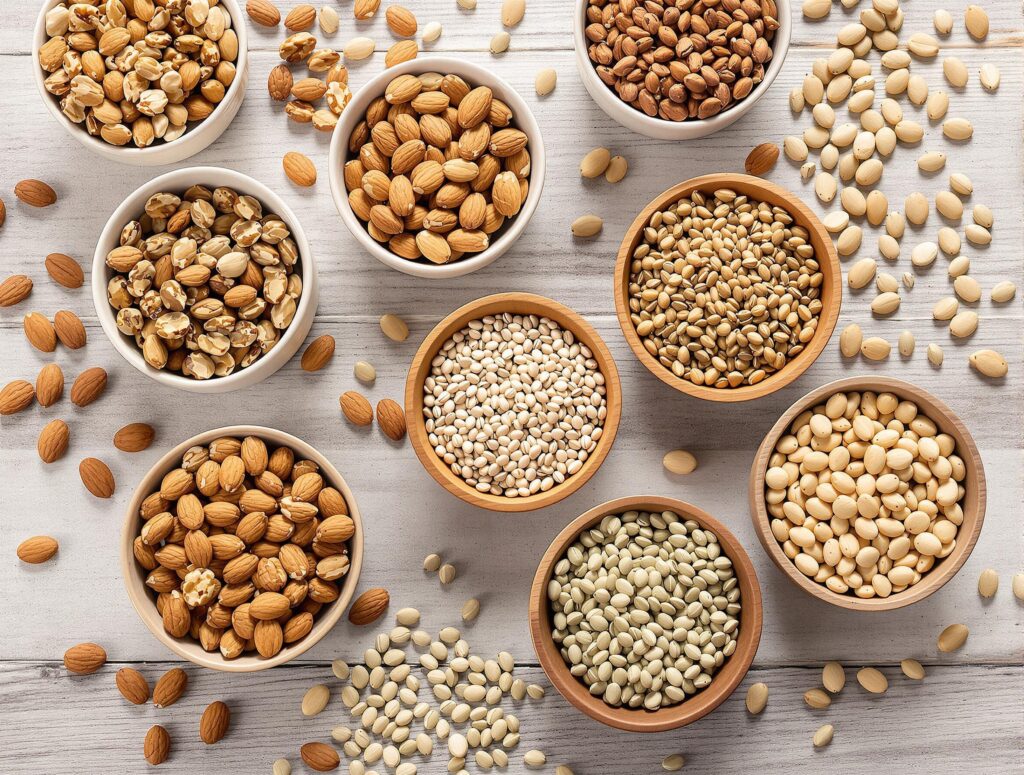Foods Good for Heart Health

Key Takeaways:
- Choosing heart-healthy foods like fatty fish, leafy greens, berries, and whole grains can help reduce cholesterol and lower blood pressure.
- Incorporating nuts, seeds, avocados, and legumes supports heart health through healthy fats, fiber, and antioxidants.
- A balanced, nutrient-rich diet is essential for protecting your heart and reducing the risk of cardiovascular disease.
A healthy heart is essential for a long, active life. The foods we eat have a direct impact on our cardiovascular health, influencing factors like blood pressure, cholesterol levels, inflammation, and weight. By choosing heart-healthy foods, you can reduce the risk of heart disease, lower bad cholesterol (LDL), and improve overall heart function.
At Mobile Care Health, we believe that you can achieve long-term heart health with the right guidance and personalized support, such as monitoring your progress and making informed dietary choices. This guide will explore the best foods to include in your diet to promote optimal heart health. These nutrient-rich options will keep your heart strong and support your overall well-being.
1. Fatty Fish: Rich in Omega-3 Fatty Acids
Fatty fish, such as salmon, mackerel, sardines, and tuna, are loaded with omega-3 fatty acids, which are essential for heart health. Omega-3s help reduce inflammation, lower triglycerides, and reduce the risk of heart disease and stroke.
Heart Benefits of Fatty Fish:
- Lower Cholesterol: Omega-3 fatty acids can help reduce harmful LDL cholesterol and increase beneficial HDL cholesterol.
- Reduced Blood Pressure: Omega-3s have been shown to lower blood pressure, reducing strain on the heart and arteries.
- Improved Blood Flow: Omega-3s help prevent blood clotting and improve blood vessel function, reducing the risk of atherosclerosis.
How to Incorporate Fatty Fish into Your Diet:
- Aim to eat fatty fish at least twice a week. Grill, bake, or broil fish for the healthiest option, and avoid frying.
- Add canned tuna or salmon to salads, sandwiches, or pasta dishes.
2. Leafy Greens: Packed with Nutrients
Leafy greens, such as spinach, kale, collard greens, and Swiss chard, contain vitamins, minerals, and antioxidants that promote heart health. These vegetables are high in potassium, which helps regulate blood pressure, and fiber, which supports healthy cholesterol levels.
Heart Benefits of Leafy Greens:
- Reduced Blood Pressure: Potassium helps balance the effects of sodium in the body, lowering blood pressure and easing the strain on the heart.
- Cholesterol Regulation: The fiber in leafy greens helps lower LDL cholesterol levels and supports overall cardiovascular health.
- Antioxidant Protection: Leafy greens contain antioxidants like vitamin C and beta-carotene, which protect the heart from oxidative stress and inflammation.
How to Incorporate Leafy Greens into Your Diet:
- Add a variety of leafy greens to smoothies, salads, and soups.
- Sauté spinach or kale as a side dish, or use them as a filling for wraps and sandwiches.

3. Berries: Full of Antioxidants
Berries like blueberries, strawberries, raspberries, and blackberries are packed with antioxidants, particularly anthocyanins, which have been shown to improve heart health. These antioxidants help protect the heart by reducing inflammation, lowering blood pressure, and preventing oxidative damage to blood vessels.
Heart Benefits of Berries:
- Lower Blood Pressure: With their high levels of antioxidants and fiber, Berries can help reduce high blood pressure.
- Reduced Inflammation: Berries’ antioxidants help combat inflammation in the blood vessels, reducing the risk of heart disease.
- Cholesterol Control: Studies show that berries can help lower cholesterol levels, including total and LDL cholesterol.
How to Incorporate Berries into Your Diet:
- Add fresh or frozen berries to oatmeal, yogurt, smoothies, or salads.
- Use berries as a natural sweetener in desserts or snacks, such as homemade fruit parfaits.
4. Whole Grains: High in Fiber
Whole grains, including oats, quinoa, brown rice, barley, and whole wheat, are excellent sources of soluble fiber, which helps lower cholesterol levels and supports heart health. Whole grains also provide essential vitamins and minerals, such as B vitamins, magnesium, and iron.
Heart Benefits of Whole Grains:
- Lower Cholesterol: The soluble fiber in whole grains binds to cholesterol and helps remove it from the body, reducing LDL cholesterol.
- Improved Blood Sugar Levels: Whole grains help regulate blood sugar levels, which is particularly important for individuals with diabetes or prediabetes.
- Reduced Risk of Heart Disease: Studies have shown that people who consume more whole grains have a lower risk of developing heart disease.
How to Incorporate Whole Grains into Your Diet:
- Start your day with a bowl of oatmeal or quinoa for breakfast.
- Replace refined grains with whole grains in meals, such as switching white rice for brown rice or using whole-wheat pasta instead of regular pasta.
5. Nuts and Seeds: Healthy Fats and Protein
Nuts and seeds, such as almonds, walnuts, flaxseeds, chia seeds, and sunflower seeds, are rich in healthy fats, fiber, protein, and antioxidants. These nutrient-dense foods support heart health by lowering cholesterol, reducing inflammation, and promoting healthy blood pressure levels.
Heart Benefits of Nuts and Seeds:
- Improved Cholesterol Levels: Nuts like almonds and walnuts have been shown to lower LDL cholesterol and increase HDL cholesterol, improving overall heart health.
- Reduced Inflammation: The omega-3 fatty acids and antioxidants in nuts and seeds help reduce inflammation in the body, reducing the risk of heart disease.
- Blood Pressure Regulation: Nuts and seeds, especially those high in potassium (like flaxseeds and walnuts), can help regulate blood pressure and reduce strain on the heart.
How to Incorporate Nuts and Seeds into Your Diet:
- Snack on a small handful of nuts or add them to yogurt, salads, or smoothies.
- Sprinkle chia seeds or flaxseeds onto oatmeal, or mix them into baked goods like muffins or energy bars.

6. Avocados: Healthy Fats for the Heart
Avocados are packed with monounsaturated fats, which have been shown to reduce bad cholesterol (LDL) levels and increase good cholesterol (HDL). They are also rich in fiber, potassium, and antioxidants, making them a heart-healthy addition to your diet.
Heart Benefits of Avocados:
- Reduced Cholesterol: Avocados’ monounsaturated fats help lower LDL cholesterol and raise HDL cholesterol, promoting a healthier heart.
- Improved Blood Pressure: Avocados are high in potassium, which helps balance sodium levels in the body and regulate blood pressure.
- Anti-Inflammatory Properties: Avocados’ antioxidants help reduce inflammation, protect blood vessels, and reduce the risk of heart disease.
How to Incorporate Avocados into Your Diet:
- Add avocado slices to salads, sandwiches, or wraps.
- Make guacamole for a healthy dip or spread, or blend avocado into smoothies for added creaminess.
7. Legumes: Protein-Rich and Heart-Healthy
Legumes such as beans, lentils, chickpeas, and peas are rich in plant-based protein, fiber, and essential nutrients. These foods have been linked to lower cholesterol levels, improved blood sugar control, and a reduced risk of heart disease.
Heart Benefits of Legumes:
- Lower Cholesterol: The soluble fiber in legumes helps lower LDL cholesterol levels, improving heart health.
- Blood Sugar Control: Legumes are low on the glycemic index, meaning they help regulate blood sugar levels, essential for heart disease prevention.
- Weight Management: Legumes are filling and low in calories, making them an excellent choice for maintaining a healthy weight and reducing the strain on the heart.
How to Incorporate Legumes into Your Diet:
- Add beans or lentils to soups, salads, or stews.
- Make a hearty bean dip, spread, or use chickpeas in a delicious hummus recipe.
Eating for a Healthy Heart
The foods you eat play a crucial role in maintaining a healthy heart. Incorporating heart-healthy foods like fatty fish, leafy greens, berries, whole grains, nuts, seeds, avocados, and legumes can reduce your risk of heart disease, lower cholesterol, regulate blood pressure, and improve overall cardiovascular health.
A heart-healthy diet doesn’t have to be complicated. Small, sustainable changes can make a big difference in protecting your heart and ensuring it stays strong for years. If you’re looking for personalized support or advice on optimizing your diet for heart health, Mobile Care Health is here to help.
Start nourishing your heart today and enjoy a long, active life.





